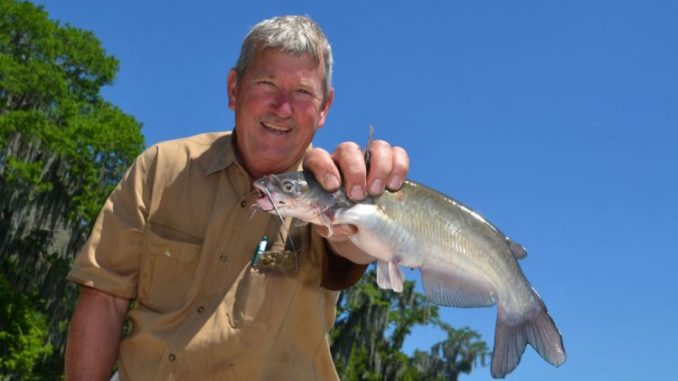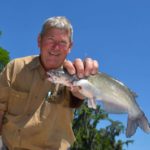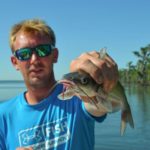
Pre-spawn catfish are feeding voraciously now in warming springtime waters. Here’s how they fill a box near the “Catfish Capitol of the Universe.”
It was a massacre.
Fish blood, poop, and slime covered the deck of the boat and the interior of the ice chest.
But wait; I’m getting ahead of myself. Let’s start at the beginning.
The water in the canal smelled fishy when we got to the landing.
But was it lying to me?
A late northerly had blown through the day before. Would it work on the catfish’s heads like it does on bass and crappie — give ‘em lockjaw? Actually, I was worried.
The cool thing (especially that day, when it was nippy early, right after the front) about catfishing in Lake Des Allemands is that you don’t have to start early.
Rudy Roussel and his father Larry planned to reach our spot at 9 a.m. “Why get up early when I never do well early,” shrugged Rudy. “I think it’s best in the middle of the day,” added Larry.
Although the lake can be accessed from numerous launches, the Roussels always launch into Moll Canal off Louisiana Highway 3127. After launching and heading south – the only way you can go from the launch – the canal dead-ended in Bayou Pain.
Rudy hung a right in the bayou, which segued into Bayou Fortier. “Stay on plane here,” cautioned Rudy. “It’s shallow.” Bayou Fortier opened into Baie d’en Haut, which is part of the lake.
Conveniently, their fishing spot was in the shallow water near the shoreline of Pointe Cypres Fausse, a big nipple-shaped point that juts far out into the open lake from its northern shore.
At a seemingly random spot, Rudy cut his big engine and unlimbered his trolling motor to move the boat into the shallows. He didn’t use the little motor for stealth, but rather because the shallow waters of the lake are littered with submerged cypress stumps and snags.
He spudded down his Power-Poles in 3 feet of water. “I have my favorite spots,” he admitted, “but you can catch catfish almost anywhere. This isn’t the only good spot in the lake. Last year, they did even better on the eastern shore.
“A lot of people like to troll and cast. I like to stay in one spot. When they stop hitting, or if I’m not catching, I’ll move 30 to 100 yards up or down the shore and stop again.”
Two rods are twice as nice
Each man quickly rigged two rods with hooks set 2 to 2 ½ feet deep beneath colorful corks. Each held one rod in his hands and laid the other on the boat’s deck beneath watchful eyes.
“You catch more fish with two rods than one, but if a fish bites the rod on the deck, you can lose it before you lay the other one down and pick that one up,” explained the elder Roussel.
“Another disadvantage, if you can call it that, is that when the bite gets hot, you can get lines between rods tangled.”
They cast in all directions from the boat. If a cast didn’t yield a quick bite, they retrieved it and tried another spot, then kept casting back to the same spot until the fish stopped biting there.
It didn’t take long. Sometimes the cork eased off sideways, but more often it did the catfish thing. The cork went “bloop” and instantly disappeared. “If you just get a nibble,” coached Rudy, “let it set and they usually take it hard.”
Spring was a good time to be on the water in the lake. It wasn’t blistering hot yet. The new foliage of the cypress trees was still vibrantly green, rather than the sunburned dark green of mid-summer.
Song birds were singing and crows were cawing, but most importantly the fish were biting. Someone always had a catfish bouncing on the water’s surface or the boat’s deck.
Rudy pulled ahead early, which really got his pop’s attention. “Ohhh, he’s ahead of me already. Now I’m really getting mad,” feigned Larry in mock anger.
But by 10 a.m. the old man was really heating up. He was handicapped earlier by his self-assumed role as the designated ice chest opener. But he gave that up quickly, leaving the lid open for both men to toss their fish into the box.
After throwing in three in a row, he was beaming.
But before noon, they had to quit. Not ‘wanted to quit’ — had to quit. The big box was so full of fat-bellied female and bullheaded male catfish from 8 inches long up to 2 pounds that the lid would barely close.
Yeah, it was a good day to be on the water.



